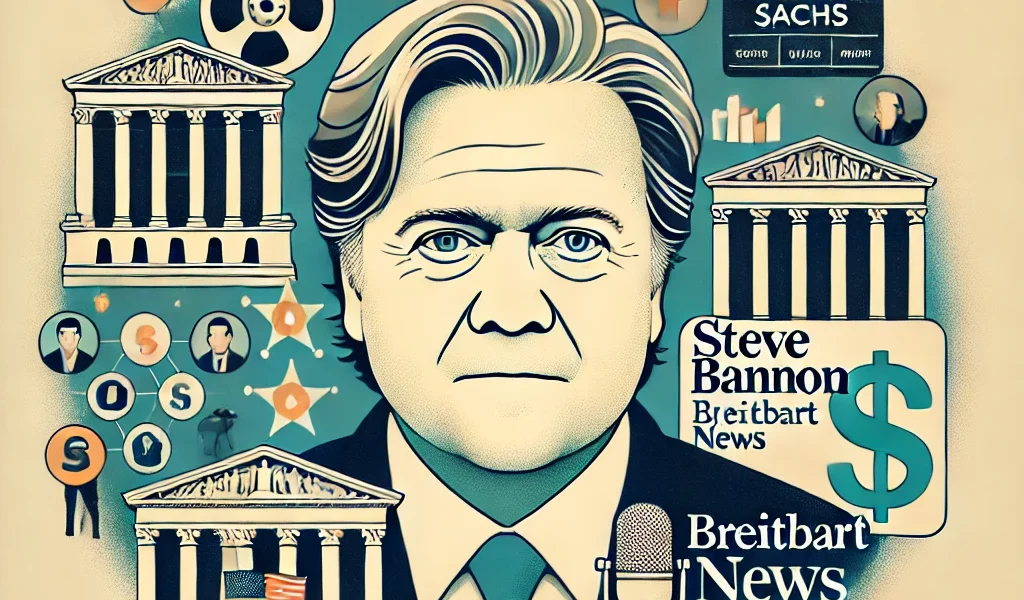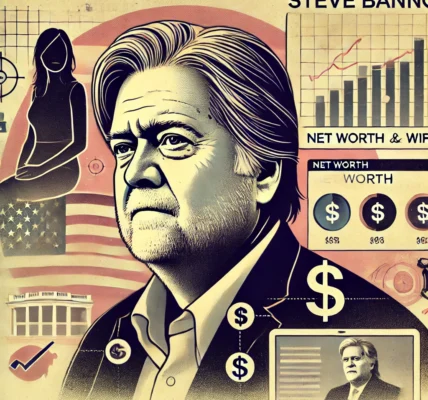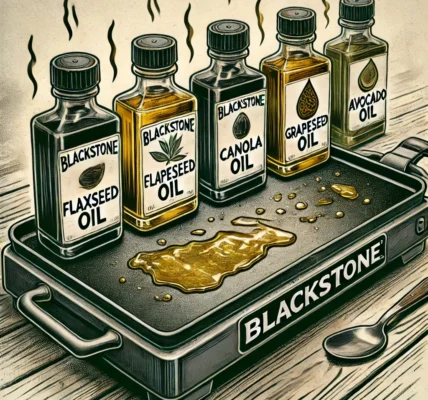How Steve Bannon Achieved a Net Worth of $48 Million
Steve Bannon, a political strategist, media executive, and former White House chief strategist for President Donald Trump, is a man of many talents and controversies. Over the years, his career has spanned multiple industries, including finance, media, and politics, contributing to his impressive net worth of approximately $48 million. While Bannon is primarily known for his role in shaping the populist movement that helped Trump win the presidency, his financial success predates his entry into the political spotlight.
In this article, we’ll explore the various stages of Steve Bannon’s career that contributed to his wealth, from his early days in the Navy and finance to his media ventures and political consulting.
Early Life and Education
Steve Bannon was born on November 27, 1953, in Norfolk, Virginia, to a working-class family. His father was a telephone lineman, and his mother was a homemaker. After attending Benedictine College Preparatory, a private Catholic military school, Bannon went on to receive a bachelor’s degree from Virginia Tech in urban planning.
After college, Bannon served in the U.S. Navy for seven years. His time in the military not only gave him discipline but also allowed him to further his education. While still serving, Bannon earned a master’s degree in national security studies from Georgetown University School of Foreign Service, followed by an MBA from Harvard Business School in 1985. His education at Harvard would be pivotal in his entry into the world of finance.
Goldman Sachs and Financial Success
After leaving the Navy, Steve Bannon began his career in finance at Goldman Sachs, one of the world’s largest investment banks. He worked in the mergers and acquisitions (M&A) department, where he learned the intricacies of corporate finance and high-stakes deal-making. This experience gave Bannon a solid foundation in understanding complex financial structures, corporate valuation, and business growth strategies.
In 1990, Bannon left Goldman Sachs to start his own investment bank, Bannon & Co., focusing on media and entertainment deals. His firm specialized in advising on the sale of entertainment assets and even represented companies like MGM and Polygram. One of Bannon’s most notable deals came when he helped negotiate the sale of Castle Rock Entertainment to Ted Turner in 1993. As part of his payment, Bannon received a small percentage of revenue from the television series Seinfeld, one of the most successful sitcoms of all time. The royalties from Seinfeld provided Bannon with a consistent stream of income, contributing significantly to his wealth.
Media Ventures and Hollywood
Bannon’s involvement in the media industry extended beyond investment banking. He took an active role in film production and worked as a producer on several films and documentaries. Some of his notable film credits include Titus (1999), The Indian Runner (1991), and In the Face of Evil (2004), a documentary about Ronald Reagan’s foreign policy. While Bannon didn’t achieve mainstream success as a Hollywood producer, his work in the industry helped expand his network and provided him with an understanding of the power of media.
In the mid-2000s, Bannon further capitalized on his interest in media by producing politically charged documentaries that reflected his growing ideological beliefs. These films were aimed at a conservative audience and promoted themes of nationalism, patriotism, and anti-establishment sentiment.
Breitbart and Political Influence
Perhaps one of the most significant chapters in Bannon’s rise to fame and fortune came when he became involved with Breitbart News. Founded by Andrew Breitbart, Breitbart News is a far-right, populist news platform known for its controversial and inflammatory content. After Breitbart’s death in 2012, Bannon took over as executive chairman and transformed the site into a major platform for the alt-right and nationalist movements in the U.S. and Europe.
Under Bannon’s leadership, Breitbart News became influential in conservative circles, attracting a massive audience and playing a critical role in shaping political discourse in the lead-up to the 2016 U.S. presidential election. This media presence not only bolstered Bannon’s political clout but also increased his financial influence, as Breitbart’s success attracted advertisers and supporters from across the conservative spectrum.
Breitbart’s rise coincided with Bannon’s entry into the political arena. His role at the media outlet brought him into contact with key figures in the Republican Party, including Donald Trump. Bannon’s media savvy and understanding of populist sentiments positioned him as a key strategist for Trump’s 2016 presidential campaign.
The Trump Administration and Beyond
In August 2016, Steve Bannon was appointed as the chief executive officer of Donald Trump’s presidential campaign, replacing Paul Manafort. Bannon played a crucial role in crafting the campaign’s populist, nationalist message, which resonated with a significant portion of the American electorate. Following Trump’s victory, Bannon was appointed White House Chief Strategist in January 2017.
Bannon’s time in the Trump administration was short-lived; he left his position in August 2017 after reported conflicts with other key figures in the White House. However, his influence on the Trump administration’s policies—particularly regarding immigration, trade, and nationalism—left a lasting impact.
Despite his departure from the White House, Bannon continued to be a key figure in conservative politics. He worked to promote nationalist movements in Europe and founded The Movement, an organization aimed at uniting far-right populist parties across the continent. He also continued to provide political consulting services, offering advice to political candidates and movements that aligned with his worldview.
Legal Issues and Controversies
Bannon’s path to wealth and influence hasn’t been without legal issues and controversy. In August 2020, Bannon was arrested on fraud charges in connection with the “We Build the Wall” crowdfunding campaign, which aimed to raise private funds to construct a wall along the U.S.-Mexico border. Bannon and others were accused of misappropriating funds from the campaign for personal use. In January 2021, just before leaving office, President Donald Trump pardoned Bannon, preventing the case from going to trial.
Although the legal trouble tarnished his public image, it didn’t significantly impact his wealth or standing in certain conservative circles.
Current Ventures and Net Worth
As of 2024, Steve Bannon’s estimated net worth is around $48 million. His wealth is a result of his diversified career across multiple industries, including finance, media, political consulting, and entertainment. While his involvement in various sectors has led to significant earnings, his political influence and media ventures, particularly Breitbart News, have had the most direct impact on his current financial standing.
Even after leaving the White House, Bannon has continued to make money through political consulting, media appearances, and documentary production. He remains an influential figure in conservative politics, both in the U.S. and abroad, although his role is often behind the scenes.
How Bannon Amassed His Wealth: Key Factors
- Goldman Sachs and Bannon & Co.: Bannon’s financial success began with his time at Goldman Sachs and his own investment firm, where he handled major media deals, including his acquisition of Seinfeld royalties.
- Media Production: Bannon’s work in Hollywood as a film producer provided him with additional income streams and expanded his influence in the media world.
- Breitbart News: Leading Breitbart to become a significant force in far-right media not only bolstered Bannon’s political influence but also added to his financial portfolio.
- Political Consulting: Bannon’s involvement in national and international populist movements continues to provide him with opportunities for consulting and strategy work.
- Royalties and Investments: Income from his business deals, royalties from Seinfeld, and smart investments have allowed Bannon to maintain and grow his wealth over time.
Conclusion
Steve Bannon’s net worth of $48 million is a result of a long and varied career, spanning industries from finance to media to politics. His ability to adapt, build influential networks, and capitalize on opportunities has allowed him to maintain financial success even amid controversy. Whether through his work in investment banking, his leadership at Breitbart News, or his political consulting efforts, Bannon’s wealth reflects his complex and multifaceted career trajectory. Despite legal troubles and public scrutiny, Bannon remains a wealthy and influential figure, both in the U.S. and internationally.




